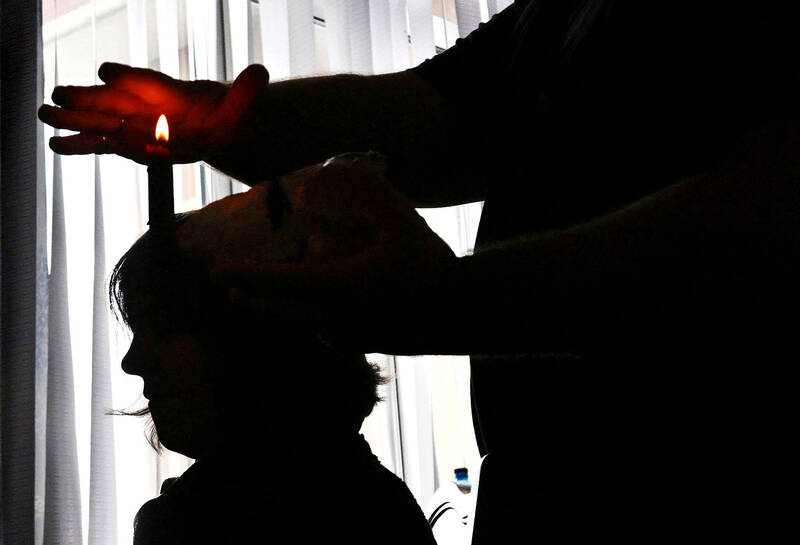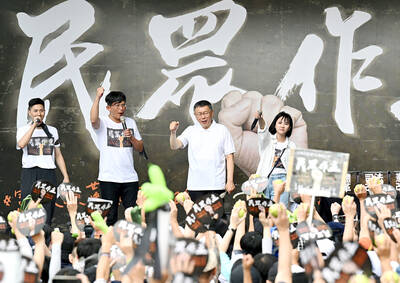For decades, possibly centuries, magicians have fretted and argued over if and when it is acceptable to reveal the secrets of their tricks and illusions.
Now two British academics — who are magicians themselves — have written what is believed to be the first detailed study examining what is known in the trade as “exposure”.
Gustav Kuhn and Brian Rappert, academics from the universities of Plymouth and Exeter, asked hundreds of magicians from around the world about attitudes to exposure.

Photo: AFP
They found that exposing another magician’s trick when they are still alive was a big no-no, with fewer than 3 percent feeling this was acceptable.
However, it was deemed much more justifiable to expose a trick invented by a magician who was dead or to explain how an illusion you had developed yourself was done.
It was seen as wrong to reveal a trick for self-promotion and, while many thought it reasonable to pass on the secrets of a trick to a fellow magician, it was much less acceptable to draw back the curtain to someone who just wanted to know how it was done for the sake of it.

Photo: AP
Rappert and Kuhn, both members of the Magic Circle, are readying themselves for flak when their paper is published on Monday.
“It’s a huge, really controversial topic within the magic community,” said Kuhn, of the school of psychology at the University of Plymouth and an exponent of closeup and street magic. “Magicians get emotional about it.”
As in most aspects of modern life, money appears to come into it. Kuhn said: “If you pay for a magic trick, it’s OK to expose the magic secrets. If you pay me for the secrets, then I’m allowed to expose it, but if I give you the secret for free, then that’s not OK.

Photo: AFP
“Magic could only advance through the sharing of certain secrets and magicians need to make a living so that financial transaction seems to play a really important part.”
Kuhn was at the center of a storm in 2019 when the global charitable foundation Wellcome Trust ran a free exhibition called Smoke and Mirrors in London that explicitly explained general principles in magic, such as misdirection and forcing.
Kuhn, whose research featured in the show, said some magicians saw the free access to such information as a violation of the rules and he was formally investigated by the Magic Circle’s exposure committee.
“It seems very unlikely that the exhibition would have created the same kind of controversy had visitors been charged an entry fee,” he wrote in a paper.
It also examines some of the history of exposure, highlighting how the first president of the Magic Circle, David Devant, was forced to resign after extracts from his book Secrets of My Magic appeared in a popular magazine.
The paper investigates twisty tricks where some exposure arguably enhances a show. For example, the magician Caleb Morgan performed the classic trick in which he stuffed a silk bandana into his clenched hand only to open his fist to show the bandana had transformed into an egg.
Morgan then revealed the egg was plastic with a hole in the back for the bandana to enter — before cracking the egg to demonstrate it was, in fact, a normal egg.
Rappert, whose work includes using magic to convey how disclosure and concealment figure in everyday life and international relations, said this sort of exposure seemed acceptable.
“Some said it was perfectly fine to unveil a closely guarded secret if it’s in the context of performing a trick that relies on a different method.”
Kuhn and Rappert argue the study is needed because the internet has made it much easier for tricks to be exposed and therefore changes the rules of the game.
Their paper ends with a comment from the Magic Circle, which was shown the research before publication. The organization sternly makes it clear it was founded in 1905 upon the tenet of protecting the secrets of magicians.
But it adds: “The ramifications and implications of exposure are a grey area which are little understood and understudied. We welcome and applaud any research of this nature that helps us all to gain a better insight and understanding.”
The paper, Towards a Theory of Exposure, is available in the Journal of Performance Magic.

In the next few months tough decisions will need to be made by the Taiwan People’s Party (TPP) and their pan-blue allies in the Chinese Nationalist Party (KMT). It will reveal just how real their alliance is with actual power at stake. Party founder Ko Wen-je (柯文哲) faced these tough questions, which we explored in part one of this series, “Ko Wen-je, the KMT’s prickly ally,” (Aug. 16, page 12). Ko was open to cooperation, but on his terms. He openly fretted about being “swallowed up” by the KMT, and was keenly aware of the experience of the People’s First Party

Aug. 25 to Aug. 31 Although Mr. Lin (林) had been married to his Japanese wife for a decade, their union was never legally recognized — and even their daughter was officially deemed illegitimate. During the first half of Japanese rule in Taiwan, only marriages between Japanese men and Taiwanese women were valid, unless the Taiwanese husband formally joined a Japanese household. In 1920, Lin took his frustrations directly to the Ministry of Home Affairs: “Since Japan took possession of Taiwan, we have obeyed the government’s directives and committed ourselves to breaking old Qing-era customs. Yet ... our marriages remain unrecognized,

Not long into Mistress Dispeller, a quietly jaw-dropping new documentary from director Elizabeth Lo, the film’s eponymous character lays out her thesis for ridding marriages of troublesome extra lovers. “When someone becomes a mistress,” she says, “it’s because they feel they don’t deserve complete love. She’s the one who needs our help the most.” Wang Zhenxi, a mistress dispeller based in north-central China’s Henan province, is one of a growing number of self-styled professionals who earn a living by intervening in people’s marriages — to “dispel” them of intruders. “I was looking for a love story set in China,” says Lo,

Standing on top of a small mountain, Kim Seung-ho gazes out over an expanse of paddy fields glowing in their autumn gold, the ripening grains swaying gently in the wind. In the distance, North Korea stretches beyond the horizon. “It’s so peaceful,” says the director of the DMZ Ecology Research Institute. “Over there, it used to be an artillery range, but since they stopped firing, the nature has become so beautiful.” The land before him is the demilitarized zone, or DMZ, a strip of land that runs across the Korean peninsula, dividing North and South Korea roughly along the 38th parallel north. This